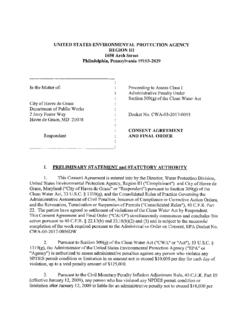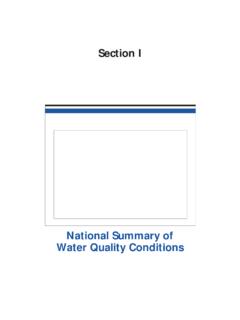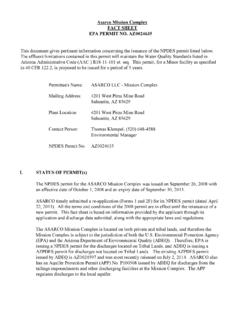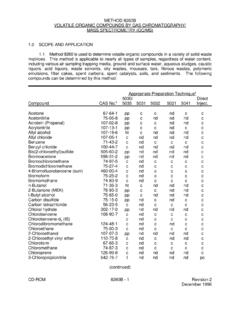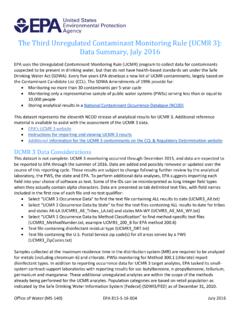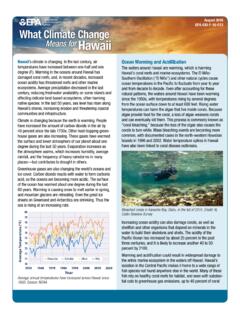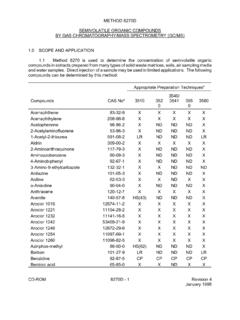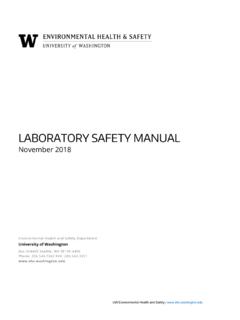Transcription of Standard Test Procedures for Evaluating Leak Detection …
1 United States environmental Protection Agency Solid Waste And Emergency Response/ Research And Development EPA/530/UST-90/005 March 1990 Standard Test Procedures For Evaluating Leak Detection Methods Nonvolumetric Tank Tightness Testing Methods Printed on Recycled Paper Standard Test Procedures for Evaluating Leak Detection Methods: Nonvolumetric Tank Tightness Testing Methods Final Report environmental Protection Agency Office of Underground Storage Tanks March 1990 iii FOREWORD How to Demonstrate That Leak Detection Methods Meet EPA s Performance Standards The environmental Protection Agency s (EPA s)regulations for underground storage tanks require owners and operators to check for leaks on a routine basis using one of a number of Detection methods (40 CFRPart 280, Subpart D).
2 In order to ensure the effectiveness of these methods, EPA set minimum performance standards for equipment used to comply with the regulations. For example,after December 22,1990, all tank tightness testing methods must be capable of detecting a gallon per hour leak rate with a probability of Detection of at least 95% and a probability of false alarm of no more than 5%. It is up to tank owners and operators to select a method of leak Detection that has been shown to meet the relevant performance standards. Deciding whether a method meets the standards has not been easy, however. Until recently, manufacturers of leak Detection methods have tested their equipment using a wide variety of approaches, some more rigorous than others.
3 Tank owners and operators have been generally unable to sort through the conflicting sales claims that are made based on the results of these evaluations. To help protect consumers,some state agencies have developed mechanisms for approving leak Detection methods. These approval Procedures vary from state to state, making it difficult for manufacturers to conclusively prove the effectiveness of their method nationwide. The purpose of this policy is to describe the ways that owners and operators can check that the leak Detection equipment or service they purchase meets the federal regulatory requirements. States may have additional requirements for approving the use of leak Detection methods.
4 EPA will not test, certify, or approve specific brands of commercial leak Detection equipment. The large number of commercially available leak Detection methods makes it impossible for the Agency to test all the equipment or to review all the performance , the Agencyis describing how equipment should be tested to prove that it meets the standards. Conducting this testing is left up to equipment manufacturers in conjunction with third-party testing organizations. The manufacturer will then provide a copy of the report showing that the method meetsEPA s performance standards. This information should be provided to customers or regulators as requested. Tank owners and operators should keep the evaluation results on file to satisfy EPA s record keeping requirements.
5 EPA recognizes three distinct ways to prove that a particular brand of leak Detection equipment meets the federal performance standards: iv 1. Evaluate the method using EPA s Standard test Procedures for leak Detection equipment; 2. Evaluate the method using a national voluntary consensus code or Standard developed by a nationally recognized association or independent third-party testing laboratory; or, 3. Evaluate the method using a procedure deemed equivalent to an EPA procedure by a nationally recognized association or independent third-party testing laboratory. The manufacturer of the leak Detection method should prove that the method meets the regulatory performance standards using one of these three approaches.
6 For regulatory enforcement purposes, each of the approaches is equally satisfactory. The following sections describe the ways to prove performance in more detail. EPA Standard Test Procedures EPA has developed a series of Standard test Procedures that cover most of the methods commonly used for underground storage tank leak Detection . These include: 1. Standard Test Procedures for Evaluating Leak Detection Methods: Volumetric Tank Tightness Testing Methods 2. Standard Test Procedures for Evaluating Leak Detection Methods: Nonvolumetric Tank Tightness Testing Methods 3. Standard Test Procedures for Evaluating Leak Detection Methods: Automatic Tank Gauging Systems 4. Standard Test Procedures for Evaluating Leak Detection Methods: Statistical Inventory Reconciliation Methods 5.
7 Standard Test Procedures for Evaluating Leak Detection Methods: Vapor-Phase Out-of-tank Product Detectors 6. Standard Test Procedures for Evaluating Leak Detection Methods: Liquid-Phase Out-of-tank Product Detectors 7. Standard Test Procedures for Evaluating Leak Detection Methods: Pipeline Leak Detection Systems Each test procedure provides an explanation of how to conduct the test, how to perform the required calculations, and how to report theresults. The results from each Standard test procedure provide theinformation needed bytank owners and operators to determine if the method meets the regulatory requirements. v The EPA Standard test Procedures may be conducted directly by equipment manufacturers or may be conducted by an independent third partyunder contract to the manufacturer.
8 However, both state agencies and tank owners typically preferthat the evaluation be carried out by an independent third-party in order to prove compliance with the regulations. Independent third-parties may include consulting firms, test laboratories, not-for-profit research organizations, or educational institutions with no organizational conflict of interest. In general, EPA believes that evaluations are more likely to be fair and objective the greater the independence of the Evaluating organization. National Consensus Code or Standard A second way for a manufacturer to prove the performance of leak Detection equipment is to evaluate the system following a national voluntary consensus code or Standard developed by a nationally recognized association ( , ASTM, ASME, ANSI, etc.)
9 Throughout the technical regulations for underground storage tanks, EPA has relied on national voluntary consensus codes to help tank owners decide which brands of equipment are acceptable. Although no such code presently exists for Evaluating leak Detection equipment, one is under consideration by the ASTM D-34 subcommittee. The Agency will accept the results of evaluations conducted following this or similar codes as soon as they have been adopted. Guidelines for developing these standards may be found in the of Commerce Procedures for the Development of Voluntary Product Standards (FR, , , June 20, 1986) and OMB Circular Alternative Test Procedures Deemed Equivalent to EPA s In some cases,a specific leak Detection method may not be adequately covered by EPA Standard test Procedures or a national voluntary consensus code, or the manufacturer may have access to data that makes it easier to evaluate the system another way.
10 Manufacturers who wish to have their equipment tested according to a different plan (or who have already done so)must have that plan developed or reviewed by a nationally recognized association or independent third-party testinglaboratory ( , Factory Mutual, National Sanitation Foundation, Underwriters Laboratory, etc.).The results should include an accreditation by the association or laboratory that the conditions under which the test was conducted were at least as rigorous as the EPA Standard test procedure. In general this will require the following: 1. The evaluation tests the system both under the no-leak condition and an induced-leak condition with an induced leak rate as close as possible to (or smaller than)the performance the case of tank testing,for example, this will mean testing under both gallon per hour and gallon per hour vi leak rates.

